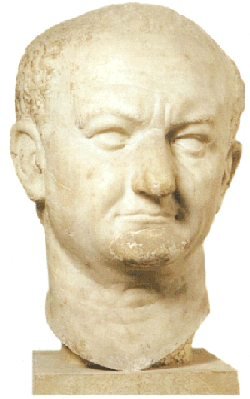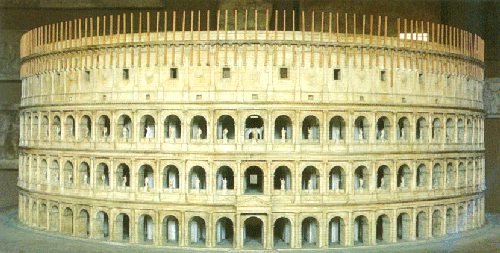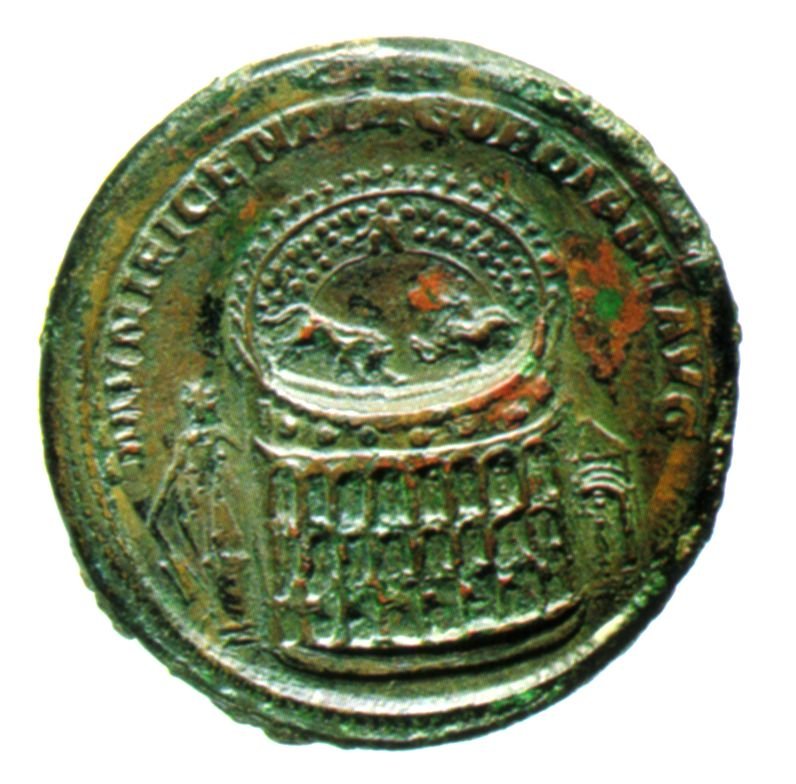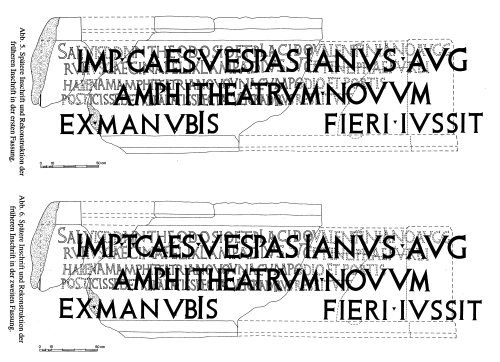
The Amphitheatrum Flavium,
a.k.a. Colosseum or Coliseum (though in olden times Romans referred to it as Amphitheatrum Caesareum or hunting theatre), was built by the Flavian emperors Vespasian, Titus and Domitian between 71-72 and 80 AD as a gift to the Roman citizens in the place where the previous Emperor Nero (37-68 AD) had his residence, the Domus Aurea. (To see what was there before Nero click here).
The city needed an amphitheatre, as the only one with a (partially) stone structure, which had been built by Statilius Taurus in 29 BC, was far too small. The emperor Caligula (12-41 AD) had started the works for a new amphitheatre, but Claudius (10-54 AD) stopped them when he came to power. Nero, too, refused to use the old Statilius’ building and preferred to have his own amphitheatre built in the Campus Martis. It was a beautiful one, according to the historians, but it was destroyed, probably in the famous fire of AD 64.

Nero’s death in 68 AD marked the end of the Julio-Claudian dynasty; the Flavian family came to power. The emperor Vespasian was acknowledged as emperor by the Senate in 69, and wanted to make a political gesture to reconcile the Roman citizens with the new dynasty. So he gave back to the Romans most of the land that Nero had occupied in the centre of the city to make his residence, and had the amphitheatre – a public facility – built in the place where once there was a huge artificial pond, in the park of Nero’s residence.

It took only about ten years to build the amphitheatre. Vespasian started the works in 72 AD and his son emperors (that’s him smiling in the statue on the right) dedicated it in the year 80 with magnificent games that lasted one hundred days.
It is generally accepted (but there are many doubts about it) that the building was completed by the following emperor, Domitian – Titus’ brother – who excavated the hypogea, i. e. the area for the preparation of the shows under the floor of the arena (which now can be visited).

In the amphitheatre, a Roman invention, were held shows that today we would condemn with horror: the most popular were the venationes (hunts) and the munera (gladiatorial games). The Roman ruling class was obliged, by law and by the expectation of the people, to organize these shows to gain the favour of the citizens. The organization of the games, which involved great expenses, became a matter of public interest and was regulated by many laws.
The whole area around the amphitheatre was dedicated to the games; near the Colosseum Domitian also built four ludi, the prisons where gladiators had their training. The bestiarii, who fought against the beasts, trained in the Ludus Matutinus, so called because the show with the animals was held in the morning. Then there were the Ludus Gallicus, the Ludus Dacicus and the Ludus Magnus. Click here for a comprehensive virtual tour of imperial Rome.

The Colosseum remained in service for four and a half centuries; there is evidence of many changes, additions and repairs. Many times the amphitheatre was destroyed by fire. Though the main structure was made of stone, a quantity of wooden elements (in the undergrounds, the arena itself, the masts of the velarium, the terraces and the roofs of the upper floor) fed the fire which in turn ruined the stone.
The first repairs were probably made during emperor Antoninus Pius (86-161), as proven by one Corinthian capital of a column of that age found by the archaeologists, after a fire had destroyed 350 houses in the city.
Major repairs, actually an almost complete rebuilding, were carried out after 217 AD, the year in which the upper floor was struck by lightning and went on fire. The embers set alight the wooden floor of the arena that in turn collapsed igniting the wooden structures beneath it and the rest of the building.
The seven companies of Vigiles (fire brigade) of the city were summoned, and also the sailors of the Castra Misenatium, who normally manoeuvred the velarium, but to no avail. The Colosseum became an enormous brazier that stopped burning only after the fuel was consumed.
Almost nothing was left of the Flavian building, and for five years the shows were held at the circus. Apparently, not much of the former building was left, as the capitals excavated in modern times have been dated at around the first half of the III century; some items date back to the II century, but none from the Flavian age.

It took more than thirty years to rebuild the Roman amphitheatre. Emperor Marcus Aurelius Antoninus Augustus, also known as Heliogabalus or Elagabalus (203 – 222) started the works. The building – still unfinished – was reopened and dedicated to the gods in 222 under Alexander Severus, who ordered that the taxes paid by pimps, prostitutes and homosexuals would be destined to the repair of public buildings, among which the amphitheatre.

In fact, the repairs were completed only in 240 under Gordian III and a coin was minted for the occasion. Gordian wanted to celebrate in Rome a lavish triumph for his victory in the war against the Persians, and had collected 32 elephants, 10 elks, 10 tigers, 60 lions, 30 leopards, 10 hyenas, 1000 couples of gladiators from the imperial ludi, 6 hippos, 1 rhinoceros, 10 bears, 10 giraffes, 20 Asiatic wild asses, 40 wild horses and many other animals.

However, Gordian died in Persia in mysterious circumstances. Persian sources claim that at the beginning of 244 Gordian fought in a battle near modern Fallujah (Iraq), which ended with a major Roman defeat and his death. Roman sources on the contrary do not mention this battle and suggest that Gordian died somewhere else, upstream of the Euphrates. Philip, who succeeded Gordian as emperor, came to Rome and used all those animals. They were first exhibited and then killed on occasion of the shows organised for the millennium of the city: April 21, 248.
The amphitheatre was again damaged – according to some sources – during the reign of Decius (201–251) or of Trebonianus Gallus (206–253). Decius led many persecutions against the Christians: among the victims were the bishop of Rome, Fabianus, and the future saints Ireneus, Abundius and Policronius. Two Persian subregoli (vassals), Abdon and Sennen, were executed in the arena and their bodies were left in the area between the Colosseum and the Meta Sudans, in the spot where a small church was later dedicated to them in the V century; this church was still there in the XV century.
In 262, during the reign of Gallienus (218-268) a violent earthquake devastated the Eastern Mediterranean; also Rome was affected, so much that the following year a plague epidemic spread in the city.
In 312 the Senate dedicated to the emperor Constantine the triumphal arch that is still standing near the Colosseum, and replaced the face of the Colossus with that of the new emperor. The head of Constantine was found in the XVI century between the pedestal of the statue and the Meta Sudans and it is now in the Capitoline Museums.
In 320 the amphitheatre was again struck by lightning, but it wasn’t heavily damaged. From this date onwards no more fires are reported, but there have been many earthquakes.In 357 the emperor Constantius II (317-361) visited Rome and was very impressed by the amphitheatre. The historian Ammianus Marcellinus that same year described it as in very good conditions.
The last gladiatorial combat is recorded in 404, after emperor Theodosius established Christian orthodoxy, banned paganism and started persecuting its followers. Pagan holidays were abolished, the Temple of Vesta destroyed, the Vestal Virgins disbanded and auspices and sacrifices were considered witchcraft and punished. So it was in this period that most ancient Roman traditions and lifestyle ceased to exist. Also, from these years we have no further literary information about the Colosseum, and the only sources are the texts of inscriptions on stone slabs.
From 408 to 410 the city was besieged by Alaric (370 – 410), king of the Visigoth. In the end his troops plundered the city for three days. During the Visigoth war the amphitheatre was completely abandoned and its surroundings actually became a burial site, as the sieges prevented the Romans from burying the dead outside the walls. After the war these cemeteries were “reclaimed” by burying them under 2 metres of earth, and one of them was rediscovered only in 1895.
89 burial places, dating from Diocletian to Theodoric times (IV-VI century) have been found in the valley of the Colosseum, mainly in the NE sector. 63 burial places have been found in and around the amphitheatre, though only 56 have been mapped. These 56 are located in 3 places. 15 ones on the eastern side and 18 on the northern side were placed outside the travertine paving around the amphitheatre, which was still in use. The third group of 23 tombs (from the VI century) were found inside the northern portico.
So the obvious conclusion is that during the V century the area around the amphitheatre was abandoned, but the facility was still in use; in the VI century, when the amphitheatre was finally closed, it was used for burials.
The trauma of the Visigoth sack induced about half the population to leave the city. At the end of the IV century Rome still counted between half a million and one million inhabitants, but after the shock of the invasion their number halved. The following sacks furtherly reduced the population and at the end of the V century/beginning of the VI there were only about 100.000 Romans left in the city. The Visigoth sack might have obstructed the drains of the amphitheatre, flooded the hypogea and maybe also ruined part of the upper porch, that had collapsed in the cavea, since it was once again repaired between 417 and 423 by the Praefectus Urbi Iunius Valerius Bellicius, probably together with Praefectus Urbi Rufius Cecina Felix Lampadius, who is mentioned in another inscription.
How do we know all this? It is an interesting story.


Between 425 and 450, probably after the 443 earthquake, Praefectus Urbi Lampadius carried out more restoration works on the arena, on the podium and on the terraces – at his own expense, as he left inscribed on a marble slab that is still in the Colosseum.
This particular inscription is also important because the marble slab had been recycled: beforehand it had carried another inscription, made of bronze letters. These letters were secured to the slab by metal pegs, that left holes in the marble. The holes allowed to reconstruct the former inscription, that was deciphered in 1995 by scholar Geza Alföldy, a specialist in reconstructing “ghost” inscriptions, so it was found that the bronze former inscription was by the Flavian emperors Vespasian and Titus, and it declared that the amphihteatre had been built with the spoils of the Palestinian war and the plundering of the Temple of Jerusalem.

After the 429 and 443 ones, another earthquake devastated Rome in 470, and in between, in 455, the city was again sacked, this time for fifteen days, by the Vandals of Genseric (a.k.a. Gaiseric, 389– 477).
Another inscription commemorates the repairs carried out by patrician Messius Phoebus Severus in 470, but the last restoration works mentioned are the ones paid in 484 or 508 by the Praefectus Urbi Decius Marius Venantius Basilius after an earthquake. See the text or the photo.
In any case these works weren’t the last to be carried out in the amphitheatre: the arena floor was again raised during the VI century, as stated by the fragments of an inscription found in the amphitheatre which has disappeared but that at the time had been transcribed. This last inscription commemorated the works made by Anastasius, a senator of the period following the fall of the Western Empire.
The last venatio is recorded in 523. Gradually the taste of the public had changed, but the main reason for the end of the games was the military and financial crisis in the western part of the empire, together with the many invasions Italy had suffered. No one could bear the colossal expenses needed to organize the shows, and this made the function of the building obsolete. Perhaps some venationes were held until the end of the VII century (Gentili), but in the VI-IX centuries the amphitheatre was completely abandoned.
In medieval times houses and churches were built in the Colosseum,which was also used as a fortress/residence by the barons of Rome.
Read about it in the next history page: Middle Ages.
The main source for this page is “Il Colosseo” – AA. VV. – Care of Ada Gabucci, Electa, Milan 1999
